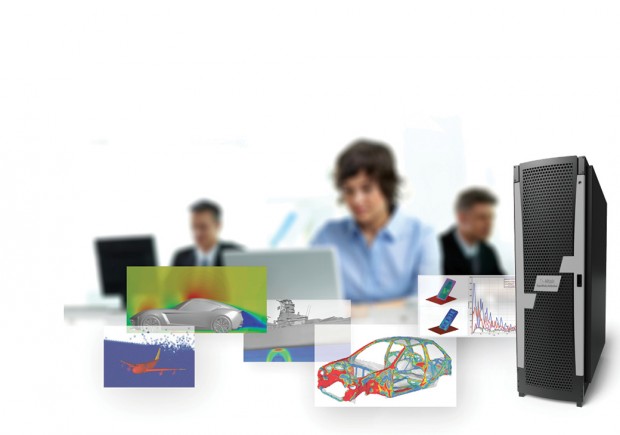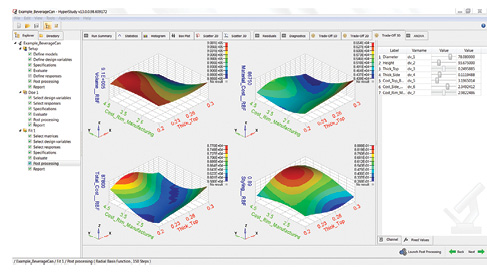
Image courtesy of Altair.
Latest News
April 1, 2015
The beginning of the design process can involve as much as art as science, and a lot of trial and error. In the past, the ability of engineers to explore the design space and come up with optimal solutions has been limited by time, computing resources and even the experience of the design team.
Technology is changing that. Specifically, design exploration and optimization strategies, combined with high-performance computing (HPC), can help engineers make faster decisions about key design criteria, run through and eliminate more iterations faster, and reduce the amount of manual labor required during all phases of design.
“Traditional product development and conceptual design is very frequently based on engineering intuition, which is great if you have a well-understood problem that has been more or less solved,” says Bruce Jenkins, president of Ora Research. “But if you require fundamental innovation in the conceptual engineering phase, these tools can be of great value. These are situations in which the best solutions may lie far outside of the experience envelope of the engineers.”
Exploration vs. Optimization
Design exploration and optimization are two parts of the design process that have benefited greatly from automation and HPC capabilities, although not all engineering teams and managers understand the difference between the two concepts.
Exploration takes place early in the process, as engineers grapple with defining the functional parameters of a product. “Design exploration is used to understand the relationships between inputs to design systems and outputs, and to understand the physics of the problem you are trying to solve,” says Fatma Kocer, business development director at Altair. “It can be used to sample the design space to create analytical functions and do faster trade-off studies.”
The term “optimization” can refer to numerical optimization that takes place at the beginnning of a design to help lead engineers down the correct path, topology/structural optimization that focuses on specific elements of a model — often to balance material placement vs. loads, for example, and even software that streamlines multi-disciplinary design workflows.
Adding to the confusion is that the various optimization technologies are sometimes referred to as design exploration, though they are actually a subset of that process.
“Design exploration is an umbrella,” says Bob Ryan, president of Red Cedar Technology, “and you can think of optimization as being underneath it.”
Thousands of Options
While most engineering departments are pretty familiar with existing structural optimization tools, new exploration solutions are emerging that could provide drastic improvements in efficiency. Autodesk’s Project Dreamcatcher, for example, is a goal-directed design system that could allow designers to input design objectives, and then generate tens or thousands of different options that meet those goals. It does so by evaluating design trade offs rapidly (in the cloud) and then providing results that allow designers to sidestep repetitive computing tasks and concentrate on creative design.
Using this concept of computational or generative design, Autodesk already helped create a carbon fiber swingarm for the LS-218 electric motorcycle from Lightning Motorcycles in California. Bentley Systems’ GenerativeComponents (GC) solution, which is primarily aimed at the architectural market, is a similar solution.
There is no shortage of other design exploration tools that include some level of optimization functionality: Altair’s HyperStudy, Red Cedar’s HEEDS MDO, ESTECO’s modeFRONTIER, Noesis Solutions’ Optimus, PTC’s Creo BMX and Siemens PLM Software’s LMS Virtual.Lab Optimization among them. CD-adapco, which acquired Red Cedar in 2013, announced earlier this year that STAR-CCM+ v10.02 would focus on Multidisciplinary Design Exploration (MDX) and improving productivity.
Exploration also helps reveal design possibilities that might never have emerged using traditional methods. “You get better designs faster,” Ryan says. “Rarely are you trying to find the optimal design, just to get a better design quickly. Software might tell you that one design is better than three others, but those others might have characteristics you didn’t build into the problem statement.”
Once that better design is identified, optimization tools can be used to further refine specific elements within known parameters.
Simpler User Interfaces Aid Adoption
These exploration and optimization techniques aren’t so much replacing a human activity as engaging in a process engineers couldn’t perform manually: running through thousands of design possibilities in a very short period of time. A major change in design exploration has been the way that new software tools have made it possible for more engineers to use these complex techniques for exploring the design space.
“What the technology does is enable engineers to quantitatively rather than intuitively evaluate large numbers of design alternatives,” Ora’s Jenkins says. “And to evaluate multiple performance criteria simultaneously and in interaction with one another in a way that older processes really didn’t accommodate.”
Typically, exploration includes design of experiments, multi-disciplinary optimization, multi-objective or Pareto optimization, process automation and stochastic simulations. Engineers can use these tools to examine the relationships among different variables without the need to perform more CAE evaluations or experiments.
Most of these capabilities were commercially available decades ago, but were difficult to learn, use and integrate with complementary tools like simulation solvers. Now, CAE models can rebuild across a wider part of the design space, engineers have access to more compute resources to run iterations in parallel, and design exploration strategies are much less cumbersome.
 Design exploration tools enable engineers to quickly and easily perform trade-off studies throughout the design process, and help identify the best design.
Design exploration tools enable engineers to quickly and easily perform trade-off studies throughout the design process, and help identify the best design.Image courtesy of Altair.
“The technology, both the software and hardware, has matured to the point now that it is much more economical and efficient to employ optimization algorithms to high-fidelity simulations,” says David Vaughn, vice president of marketing at CD-adapco. “The cloud has also changed things. You can get much more high-performance computing power per dollar.”
In the past, companies would develop simulation models and then hand them to optimization groups. “Nobody learned anything, and it was laborious,” Red Cedar’s Ryan says. “You would turn the model over to someone who was interested in math, not the product. The engineer is the one who should be learning about sensitivities and finding things in the study that are interesting and help build insight.”
And many engineers are still doing much of this work manually. Improving the user interface so that engineers can quickly and easily run through iterations and learn from them is a key advancement.
“We’ve focused on simplifying the use of these products,” Altair’s Kocer says. “The products have traditionally been targeted at experts rather than practitioners. Now you can use these tools without having to spend too much time learning how to apply the technology.”
A Cultural Shift
Leveraging both exploration and optimization technologies requires more than just installing some software or accessing HPC resources. Engineering departments may need significant re-training to get the most out of these tools, which automate processes that in many companies relied on highly manual trial and error.
Vaughn says that CD-adpaco’s customers have taken a variety of approaches. Some have actually created design exploration departments, or multi-disciplinary teams to work on specific projects. “The unmanned aerial vehicle (UAV) industry is a good example,” Vaughn says. “Many of these companies started in a garage, and they had small groups of engineers taking a product from start to finish in a multi-disciplinary way. They could readily employ design exploration techniques because the organization itself was structured to take advantage of that.”
ESTECO often initially helps companies automate existing processes to help the engineers make the transition. “For newcomers we replicate a process that they are comfortable with,” says Carlo Poloni, president at ESTECO. “If the engineer trusts the manual simulation, he will also trust hundreds of simulations done in the same way.”
The idea of throwing designs back and forth “over the wall,” has become outdated. The gulf between CAD and CAE has to be bridged in a more intelligent way.
“Leading companies are changing the way CAD is done first,” Ryan says. “It has to be robust, and should be able to be rebuilt automatically across a whole range of potential design changes. Then you give a real live dynamic model to the CAE engineers. That’s huge in terms of its importance to doing design exploration.”
“The mindset of the engineer has to move from trial and error to process driven, and from single simulations to multi-simulation,” Kocer says. “If [design teams are] using multi-disciplinary optimization, then departments in each discipline have to get together and discuss fair trade offs and compromises, and formulate the problem they need to solve.”
Speaking the Engineer’s Language
Many of these tools still require a certain amount of expertise and understanding to set up a problem and execute it, according to Jenkins. Further innovations will center on making the tools even easier to use. “There are a number of different quantitative and statistical methods used, and some of the solutions still require parameter tuning,” Jenkins says. “The engineers need to know something about which of the algorithms is being used.”
The interface will be presented in the language of the engineer. “We have to look at the software interface, and find ways to make sure the practitioner can use this, and use terminology that is meaningful to the engineer,” Kocer says.
ESTECO’s Poloni agrees that ease of use will be a major focus in the industry. “We are moving into a world that is more collaborative thanks to Web technologies,” Poloni says. “This will allow users to build even more sophisticated models during design exploration.”
With a simplified interface, the exploration tools can do a better job of helping engineers more efficiently improve designs. “Good exploration software will allow what I call collaborative exploration,” Ryan says. “The engineer is participating and injecting designs in the process. You can change the geometry, have it updated, and see what happens. Then these intelligent strategies will start to help you find things you never would have thought of before.”
More Info
Subscribe to our FREE magazine, FREE email newsletters or both!
Latest News
About the Author
Brian Albright is the editorial director of Digital Engineering. Contact him at [email protected].
Follow DE






